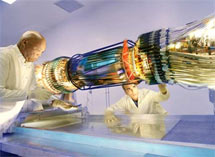
Handy Links
SLAC News Center
SLAC Today
- Subscribe
- Archives: Feb 2006-May 20, 2011
- Archives: May 23, 2011 and later
- Submit Feedback or Story Ideas
- About SLAC Today
SLAC News
Lab News
- Interactions
- Lightsources.org
- ILC NewsLine
- Int'l Science Grid This Week
- Fermilab Today
- Berkeley Lab News
- @brookhaven TODAY
- DOE Pulse
- CERN Courier
- DESY inForm
- US / LHC
SLAC Links
- Emergency
- Safety
- Policy Repository
- Site Entry Form

- Site Maps
- M & O Review
- Computing Status & Calendar
- SLAC Colloquium
- SLACspeak
- SLACspace
- SLAC Logo
- Café Menu
- Flea Market
- Web E-mail
- Marguerite Shuttle
- Discount Commuter Passes
-
Award Reporting Form
- SPIRES
- SciDoc
- Activity Groups
- Library
Stanford
Around the Bay
BaBar SVT: Eight Years of Great Physics
 Right at the center of BaBar, inside its protection shield, lives the Silicon Vertex Tracker (SVT), a complex device that uses silicon crystals coated with superfine metal strips (about 300,000 of them) to accurately measure the position of the charged particles crossing it. Following these footprints, it is possible to find the point of origin of the particles—the Vertex—pretty much in the same way that
by following the tracks left by a rabbit running on fresh snow it is possible to find its burrow.
Right at the center of BaBar, inside its protection shield, lives the Silicon Vertex Tracker (SVT), a complex device that uses silicon crystals coated with superfine metal strips (about 300,000 of them) to accurately measure the position of the charged particles crossing it. Following these footprints, it is possible to find the point of origin of the particles—the Vertex—pretty much in the same way that
by following the tracks left by a rabbit running on fresh snow it is possible to find its burrow.
The Vertex tells us where the parent particle decayed, and the measurement of its location is essential to disentangle the intricacies of matter-antimatter oscillations as well as to sift precious, revealing, very rare B-meson or τ-lepton decays from the much more abundant and mundane background. Most of the time two Vertices are produced, and the SVT is able to measure the difference in decay times with a resolution of one millionth of a millionth second.
The SVT design and construction was carried through by a strong team of Babar collaborators from Italy and the U.S., led by Lawrence Berkeley National Laboratory Physicist Natalie Roe and myself, from Pisa. Its landmarks surprisingly track my personal achievements: the fabrication started in 1995, when my daughter Viviana was born, and the installation was completed in spring 1999, just weeks before the birth of my son Fabio.
The SVT, and my son, turn eight this year, which is a record-setting age for a silicon vertex detector. In fact, most vertex detectors need significant repairs or replacements after a few years because of the massive amounts of radiation they receive, causing dislocations in the crystalline structure of the silicon and electric charge accumulation in the silicon dioxide layer that protects the detector surface. Since the amount of charge released by a crossing particle is tiny (about four millionth of a billionth of the charge that goes through a 100 watt bulb in a second), any distortion is terribly damaging.
Because of this sensitivity, we introduced as much redundancy as practical in the SVT design. The sensors are as radiation hard as possible, and the five measurement layers enable BaBar to efficiently reconstruct low momentum particles while providing extra leverage to cope with failures.
So far, the SVT has received more than 2 million radiation absorbed doses (about 20 million times the general annual occupational dose limit at SLAC) and in spite of some broken element is still going strong and helping BaBar produce exciting new physics results.
—Francesco Forti, SLAC Today, July 12, 2007
Above photo: The Silicon Vertex Tracker. (Image courtesy of Peter Ginter.)